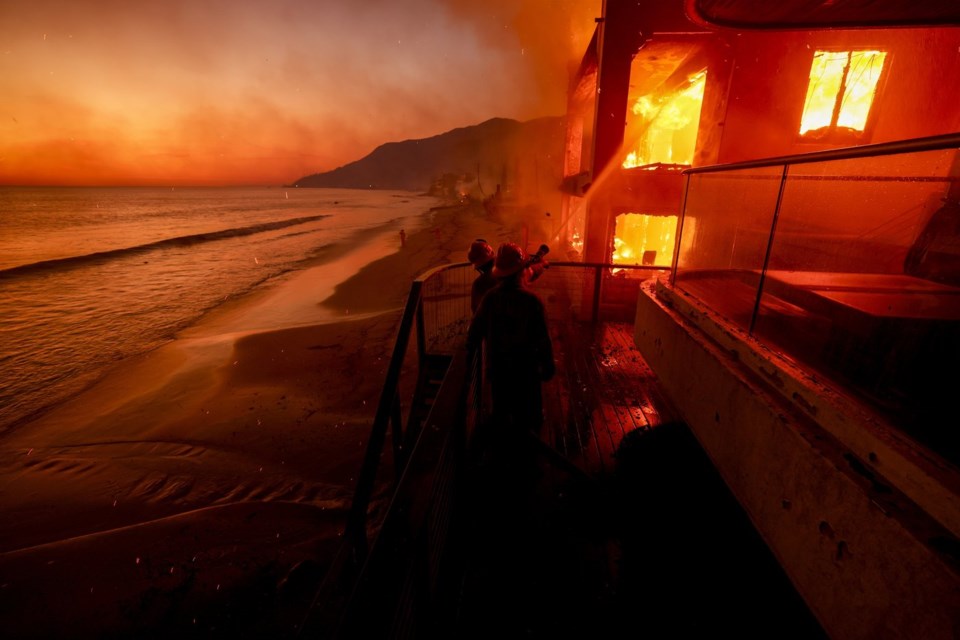NEW YORK (AP) — They seem endless, these sapping stories of loss. A grandfather starts over in his 90s. A family loses their dream home. People who were already struggling are dealt new, brutal blows.
As California's massive wildfires burn, a barrage of GoFundMe campaigns for victims have become an outlet for onlookers transfixed by the blazes and eager to do something to help. Those appeals for help — plastered with photos of saffron flames or the charcoal aftermath or, most of all, the faces of the people at the center of the plea — are personalizing a tragedy too big to comprehend.
“I feel connected in a strange way to all these people that I don’t know,” says Rachel Davies, a 27-year-old writer in New York, who went through hundreds of GoFundMe's wildfire campaigns and felt drawn in to stories of strangers, donating to fundraisers for landscapers, housekeepers and a cook.
Davies was moved by the little details of victims' stories — like the fact that someone lost their home just as they were bringing a baby home from the hospital — and compiled and circulated a list of GoFundMe sites, thinking others would feel the same and be spurred to donate.
“Those stories," Davies says, “will stick with me.”
They're offering glimpses into lives you might never see
The pages feel intimate. They serve up glimpses into the lives of a compassionate nurse or a goofy driver, and into the things they lost — be it a prized sneaker collection or the tools they counted on for work. Here, each is not some faraway, faceless victim. They're Todd or Ulli or Susan.
“People can look for someone they see as the ideal victim for them,” says Amy Pason, a professor at the University of Nevada, Reno, who has studied social movements and teaches a class on persuasion.
In an era of constant connection, on-demand expectations, pinpointed preferences and endless customization, browsability and tailoring are second nature. Why not for disaster relief, too?
Plus, Pason says, it feels to many like a “more authentic” way to give.
In a statement, GoFundMe says thousands of fundraisers have been launched in connection with the fires, including its own Wildfire Relief Fund, which has already garnered about 30,000 donations. All told, the campaigns have already raised more than $100 million for wildfire victims.
Ella Marx, a 26-year-old social worker in Ypsilanti, Michigan, is among those who chipped in. She came across an appeal from a woman who said the houses of her grandmother and three aunts were all destroyed by the fire in Eaton, California. She quickly donated $20.
Marx finds herself donating to GoFundMe campaigns every month or so. She likes them because she doesn’t have faith in the government to help victims and doesn’t like the constraints that nonprofits might put on recipients of aid. Plus, she likes the feeling of knowing who she’s donating to.
“I think it does personalize it a little more,” she says.
Stories that can touch many
Scrolling through GoFundMe's pages, there is something to pull at nearly anyone’s heartstrings. It is a veritable catalog of grief.
Runners might be drawn to a campaign organized by the Pasadena Pacers, which posted photos of members who lost homes on happier days, on a favorite trail or sporting a race-day medal. Rabbit lovers can flock to an appeal for The Bunny Museum, which paid tribute to the fluffy-tailed animal through its collection of tens of thousands of items, now all gone. A bar, a coffee shop, a mosque, a school — all are among the places left in ashes by the fire and now the subject of campaigns to bring them back.
Matthew Wade, a sociologist at La Trobe University in Melbourne, Australia, who has researched GoFundMe, says donors are drawn to the immediate gratification of their gift and the ability to follow along as their beneficiaries recover from tragedy.
“A concrete action,” he says, “in these otherwise helpless moments.”
But while some crowdfunded fundraisers result in a massive response, Wade says many raise little or nothing. Only the most uniquely compelling stories manage to garner a fickle public’s attention, he says, reinforcing existing inequalities.
“Social crowdfunding platforms are effectively markets for sympathy, where the crowd weighs claims to moral worthiness,” Wade said in an email interview.
But John Dent, who created a GoFundMe page for his cousin’s family, who lost their home in Altadena, California, remains in awe of the generosity his campaign elicited. His relatives had initially rebuffed the idea of the fundraiser but were left in tears by the response of more than $22,000 so far.
“It’s just been so powerful,” says Dent, a 52-year-old teacher from Goleta, California. “These are often people that have no clue who they are.”
___
HOW TO HELP: In addition to individual GoFundMe efforts, here are some ways to chip in.
___
Matt Sedensky can be reached at [email protected] and https://x.com/sedensky.
Matt Sedensky, The Associated Press


